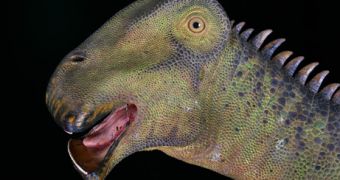Those enormous long-necked dinosaurs are presented like some kind of giraffes of the dinosaur era, devastating tree tops. But a new odd 110-million-year-old species with a vacuum cleaner-like muzzle suggests that not all of them did this, as presented in a new research published online in the journal PLoS One.
A team led by Paul Sereno, a paleontologist at the University of Chicago, discovered this species in south-central Sahara and called it Nigersaurus. It was just a 30-ft (9 m) long species related with the earlier and more famous Diplodocus, one of the most famous long-necked dinosaurs.
First bones of the species were found in the '50s in Niger by French paleontologists, but Sereno's team completed this with the 1999 discovery of supplementary fossil remains, even a skull.
The new research, employing 3-D images of the braincase delivered by CT scans, revealed that this dinosaur had adaptations that were not suspected before, like a broad, square-edged muzzle endowed with 500 to 600 replaceable teeth that were used like scissors to cut off soft vegetation.
"One of the stunning things about this animal is how fragile the skull is. Some of the bones are so thin you can shine a light through them. It is just outlandish to think that an animal which weighs nearly as much as an elephant had a skull that was featherweight," Sereno told National Geographic News.
"The scans revealed that Nigersaurus's teeth were replaced faster than those of any other dinosaur, with some ten replacements stacked up behind each one. We looked into its ear regions to try to work out which way the skull was orientated in life," said Sereno.
The dino's head appeared to have made a downward right angle with the neck.
"That made a lot of sense given the shape of the muzzle-it was mowing down plants along the ground. Nigersaurus likely ate soft plants such as young ferns and horsetails, probably lifting its neck to a horizontal level but not much higher. [Diplodocus] has also got the downturned head and square jaws. It's like a less extreme version of Nigersaurus. I think it also was a ground feeder." said Sereno.
"Nigersaurus having its head pointing towards the ground fits very nicely with how the jaws were working and what the teeth were doing. Elements of the same [feeding] system were obviously shared with other diplodocoids, but they may not have been as extreme as this," said Paul Upchurch, a paleobiologist at University College London in the United Kingdom.
"The skull of Diplodocus, for instance, probably wasn't designed to point towards the ground at such a steep angle.
Diplodocus also had a much longer neck so maybe it was able to feed not just near the ground but over a wider variety of levels," explained Upchurch.
"Looking at the skull of Nigersaurus, you would think just the slightest little bite and the whole thing would shatter. Obviously it had a way of coping with the bite forces involved." he added.
"Whereas elephants use massive teeth positioned at the back of massive jaws for eating, Nigersaurus puts its teeth in the worst position-way up front, away from the joint. The backbone of the dinosaur was likewise pushed to an extreme. The vertebrae look more like eggshells. They are more air than bone. Having such a dainty skull and backbone would have made the dinosaur much lighter, but it really does look like a walking chandelier. It's now up to biomechanics to explain how it performed these feats." said Sereno.

 14 DAY TRIAL //
14 DAY TRIAL // 
